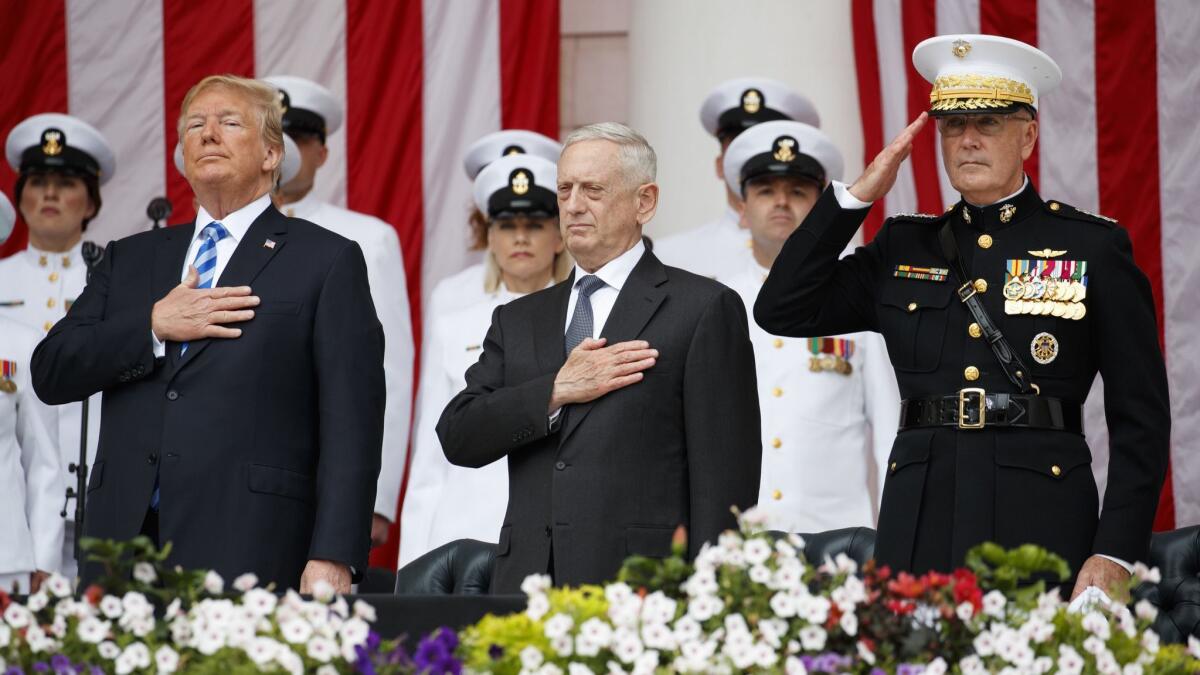Op-Ed: Trump’s ridiculous Space Force is — sadly — an extension of America’s existing national security strategy

“When it comes to defending America, it is not enough to merely have an American presence in space,” the president of the United States announced the other day. “We must have American dominance in space.”
To pursue this galactic ambition, the commander-in-chief proposes to create a new branch of the armed forces. If Trump has his way, a Space Force will soon take its place alongside the Army, Navy, Air Force and Marine Corps. While Trump’s vision may seem far-fetched — making Ronald Reagan’s abandoned “Star Wars” missile shield look positively modest by comparison — it is perfectly congruent with the trajectory of U.S. national security strategy since the end of the Cold War.
So far, the president’s initiatives have tended to be pinched, small-bore and nasty, rarely possessing anything like grandeur. In the case of the Space Force, the grandeur qualifies as genuinely breathtaking.
Aspiring to dominate outer space represents not a radical departure or a cockamamie idea, but a logical next step.
Imagine the opportunities for artistic expression: Space warriors will certainly require their own distinctive uniforms, their own flag, their own service emblem, their own decorations, their own traditions, and their own equivalent of “Anchors Aweigh.”
Imagine too the opportunities for profiteering. The president promised a “separate but equal” component of the Department of Defense. To be truly equal, the Space Force will need its own panoply of bases and signature institutions — perhaps, an orbiting service academy for educating space cadets. Almost inevitably, a new arm of the military would attract its own retinue of lobbyists, special friends in Congress, and favored contractors, providing lucrative jobs to space generals or admirals when they retire.
All in all, it makes for a dazzling prospect.
However tantalizing, the president’s proposal won’t necessarily come to pass. Like Trump’s plan for an epic military parade down Pennsylvania Avenue, if it does materialize it will be in diluted form. After all, Trump’s own Defense secretary is on the record in opposition to the creation of a “Space Corps.” So too the existing services, each of which is ever conscious of the need to guard its bureaucratic turf and protect its budget share.
Enter the Fray: First takes on the news of the minute from L.A. Times Opinion »
Most importantly, whether the president knows it or not, he lacks the authority to order the creation of a new military branch. According to the Constitution, that’s the business of Congress. And the last time Congress exercised that prerogative, establishing the U.S. Air Force and reshuffling service roles and missions in 1947, one immediate result was a bout of very public and ugly inter-service scuffling that few are keen to repeat.
Given these obstacles, we may be tempted to dismiss the president’s idea of controlling outer space as an inconsequential example of Trumpian lunacy. To do so would be a mistake, however.
Whether Trump’s Space Force ever becomes a reality, it expresses a strategic precept that America’s national security establishment has clung to for a generation. The essence of that precept can be simply stated: Only if the United States exercises unassailable dominion, always and everywhere, will the nation be truly safe. Considered from that perspective, aspiring to dominate outer space represents not a radical departure or a cockamamie idea, but a logical next step.
We can trace the origins of the logic to a document that predates Trump’s appearance on the Washington scene by a quarter century. The draft Defense Planning Guidance, prepared in 1991 under the aegis of Paul Wolfowitz, then serving as undersecretary of Defense for policy in George H. W. Bush’s Pentagon, is the Rosetta Stone of contemporary American statecraft.
For members of the foreign policy establishment, 1991 was a year of great hope and vast illusions. The United States had just won two notable successes, the first as the Soviet Union collapsed and the Cold War faded, and the second, in President George H.W. Bush’s victory over Saddam Hussein’s Iraq in the first Gulf War. Together, these successes seemed to elevate the U.S. to status of sole superpower. For officials like Wolfowitz, it was imperative to sustain that position.
As the draft DPG put it, it had become incumbent upon the United States “to prevent any hostile power from dominating a region whose resources would , under consolidated control, be sufficient to generate global power.” In 1991, the regions that mattered most included Europe, East Asia and the Persian Gulf. Yet the language was open-ended and the mandate expandable.
The mandate also came with an implicit corollary: The most expedient way of preventing others from establishing “consolidated control” over a region is for the United States itself to do so preemptively. In short, better to act than to react.
After 9/11, this corollary found expression in the Bush Doctrine of preventive war, which George W. Bush implemented in 2003 when he invaded Iraq. Conceived as a first step toward positioning the United States to dictate events throughout the Middle East, that endeavor failed abysmally, as Trump himself has noted on multiple occasions.
That a nation unable to pacify a single impoverished country like Afghanistan after 17 years of trying should contemplate attempting to control the infinite expanse of outer space will strike any sensible person as madness. Trump’s proposal that the United States should do just that suggests that in Washington, the hubris embedded in Wolfowitz’s Defense Planning Guidance is never-ending.
Andrew J. Bacevich is author of “America’s War for the Greater Middle East: A Military History.”
Follow the Opinion section on Twitter @latimesopinionand Facebook
More to Read
A cure for the common opinion
Get thought-provoking perspectives with our weekly newsletter.
You may occasionally receive promotional content from the Los Angeles Times.






